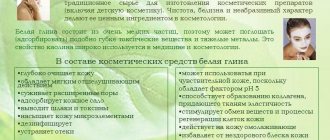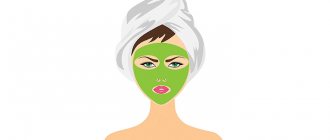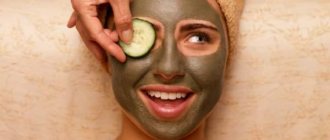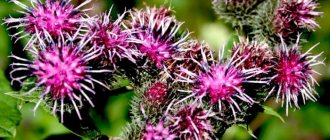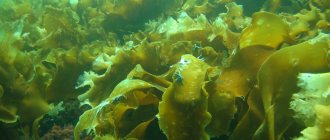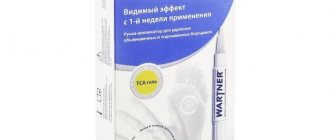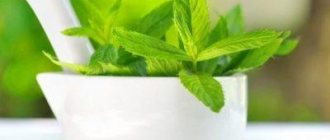- Mask recipes
Among the variety of cosmetic products for the care of the skin of the face, it is difficult to decide and buy a product that really brings the desired results. In addition, the product description does not always contain an exhaustive list of ingredients. But there is always the possibility of an allergic reaction to various components. As an alternative to purchased products, blue clay has become widespread, masks with which can be easily created at home, using only those substances that will be useful. At the same time, the cost of care is significantly reduced.
Features of blue clay in cosmetology
Blue clay for the face, the properties of which are used in cosmetology, is used for various purposes. It is taken orally, made into masks for the face and body, and used for compresses, wraps and baths.
Blue clay for the face: - one of the oldest remedies for beauty and healthy skin
The mineral substance has many healing properties:
- antibacterial;
- nutritious;
- pain reliever;
- moisturizing;
- tightening;
- stimulating;
- whitening
Cambrian clay is used for the following indications:
- eczema, dermatitis, psoriasis;
- post-acne, pimples, acne;
- seborrhea, dandruff, oily scalp;
- deterioration of skin condition of various etymologies;
- age-related changes;
- dull complexion;
- cellulite, stretch marks;
- excessive sebum production;
- black dots;
- wounds and abscesses on the skin.
The unique composition of blue clay
Blue clay for the face, the properties of which have been known since ancient times, is a finely dispersed rock of sedimentary layers. When dry it is a powder, and when moistened it becomes elastic. When added to water, clay does not dissolve, but settles to the bottom of the container.
Blue clay is also called Cambrian, as it is mined from the layer of the same name in the Russian geological platform. Previously, this area was an ancient sea that contained blue mud, which is why the rocks in this region are called blue. This color is given to the mineral by the natural dye copper chlorophyllin.
Blue clay was used in ancient Egypt to embalm bodies. There are mentions of the mineral in the notes of Aristotle, Confucius, and Galen. its medicinal properties were described by Avicena in the “Canon of Medicine” and Pliny in “Natural History”.
Louis XVI used blue clay for stomach pain. In Rus', the breed was used to cleanse the body of poisons, and during Tsarist Russia it was sold at high prices abroad. In the 19th century. in Chernigov and near St. Petersburg there were hospitals where treatment with blue clay was carried out. Famous doctors also wrote about clay therapy - S.P. Botkin and German professor Schrumpf.
Storing blue clay
To preserve the beneficial properties of blue clay, it must be placed in a clean glass or ceramic container. The powder substance is poured into a dry container with a sealed lid. In this form, the clay is left both in the open sun and in a cool place.
The wet mineral is lightly covered with a cloth or lid to allow air to enter. Keep the container with creamy clay in the refrigerator, remembering to periodically moisten it with a small amount of water.
Blue clay for face: application
A blue clay face mask requires compliance with the following rules:
- It is necessary to use non-metallic utensils so as not to deprive the composition of its beneficial properties. A container made of glass, ceramics, silicone, plastic, etc. is suitable. The main thing is not metal.
- Apply the mask only to cleansed and exfoliated skin.
- With great caution for people with sensitive skin.
- It is important not to let the mask harden completely and turn to stone. It is important to prevent cracks that will appear as the composition dries. To do this, you can moisturize your face with a spray bottle or simply moisten it with water.
- Do not apply to the area around the eyes or areas with sensitive skin.
How to dilute blue clay:
Usually blue clay is diluted to the consistency of thick sour cream. You can use various liquids for this. For example, the most popular option is water. At the same time, the composition must be mixed well enough so that there are no lumps in it.
What can you mix clay with:
- with water – basic option, suitable for any skin type and any problem
- a decoction of herbs (chamomile, sage, yarrow, nettle) - most suitable for problematic and oily skin. Can also be used for rejuvenation.
- Milk and cream are an excellent option for dry and dehydrated skin and promote rejuvenation. At the same time, do not forget to also apply moisturizers after the procedure.
- oil – suitable for dry, sensitive, normal skin. A mask made of blue clay and oil will be doubly useful, as it will impart to the skin the benefits of both components.
- Flower water will also increase nutritional properties. At the same time, the composition with floral water will be lighter and more suitable for oily and problem skin.
- green tea is an ideal remedy for improving tone, evening out color and rejuvenation. With the addition of some esters, the composition is also suitable for problem skin.
How long to keep a clay mask on?
How long to keep a clay mask on your face? Moisturizing it with water can last for a very long time. But there is not much point in this, so 15-20 minutes is enough. In fact, it is enough to apply a generous layer of clay and, as soon as it begins to tighten the skin, wash it off. This will be the simplest, most effective and affordable option in the rhythm of a modern woman. Once a week, a blue clay face mask for just 20 minutes to maintain beauty and youth!
How to remove a clay mask
The very first rule is to prevent the skin from drying out and tightening. To do this, we periodically moisturize the composition on the face. If you do overexpose it, you need to soak the clay with water. To do this, wash your face and apply wet palms to the composition. Gradually the clay will become wetter and can be gradually washed off.
Under no circumstances should frozen pieces be removed from the skin. This will only hurt her more.
Chemical composition of blue clay
Substances in blue clay affect its color and various properties. The content of components depends on the place of extraction of the rock and the soil characteristics of the region. Dark blue clay is rich in natural radium, while light blue clay has admixtures of kaolin. The older the clay, the more saturated components it contains.
| Component | Content, mg |
| Nitrogen | 4-8 |
| Silicon | 200-700 |
| Potassium | 3-6 |
| Silver | 0,3-0,8 |
| Calcium | 25-60 |
| Molybdenum | 2-4 |
| Radium | 0.006-0.012 mcg |
| Phosphorus | 2-2,5 |
| Copper | 1,5-3 |
| Aluminum | 10-40 |
| Magnesium | 4-8 |
| Manganese | 11-30 |
| Iron | 8-15 |
| Cobalt | 0,08-0,25 |
| Zinc | 5-9 |
| Nickel | 0,5-1 |
| Sodium | 10 |
| Chromium | 3-4 |
Blue clay contains titanium oxide and dioxide. These substances protect the skin from the harmful effects of solar radiation and effectively remove dead skin particles. The clay also contains kelp extract, which restores the tone of the epidermis.
Blue clay contains natural minerals:
- pyrophyllite;
- disten;
- nacrite;
- andalusite;
- muscovite;
- sillimanite;
- montmorillonite;
- kaolinite;
- monothermite;
- diaspora;
- halloysite;
- corundum;
- hydrargillite.
Useful properties of blue clay in cosmetology
Blue clay for the face, the properties of which are valued in medicine, is a natural mineral that is used for health and beauty.
Blue powder:
- smoothes wrinkles;
- improves skin tone;
- fights stretch marks;
- stimulates cellular metabolism;
- strengthens hair roots;
- gives curls shine and volume;
- eliminates dandruff;
- opens and cleanses pores;
- accelerates the regeneration of damaged tissues;
- regulates sebum production;
- kills bacteria;
- relieves swelling;
- tightens enlarged pores;
- smoothes scars and cicatrices;
- treats inflammation;
- helps cope with fungus;
- relieves pain;
- removes toxins from the body.
For women
Blue facial clay, whose properties help women's health, is used to create homemade cosmetics. Various face masks, compresses and body lotions are made from the mineral. The powder eliminates stretch marks and relieves menstrual pain.
Blue clay for women is used in case of the following diseases:
- polyps;
- mastitis;
- cyst;
- inflammation;
- mastopathy;
- discharge;
- vaginitis;
- fibroids;
- irregular cycle;
- uterine prolapse.
During pregnancy, take 1 tsp of blue clay. after meals to get rid of nausea and toxicosis. When breastfeeding, clay wraps are made to tighten the skin and smooth out stretch marks. It is useful to take baths with the mineral and make compresses on the lower abdomen. This prevents stretch marks and relieves tone. It is also not forbidden to apply masks for facial beauty.
For men
Representatives of the stronger sex use blue clay to restore sexual function and relieve swelling from the reproductive organs.
For this, 1 tsp. The mineral is diluted in 250 ml of water and consumed daily. Taking clay water – 2 tsp – helps against adenoma and prostatitis. powder per 200 ml of purified water. In the complex, lotions with blue clay are prescribed for the lower abdomen and mineral baths every other day.
For children
To relieve muscle spasms, relax and gently cleanse the skin, children are recommended to take clay baths from birth. For this, 1 tbsp. powder is diluted in warm water. The duration of the procedure is 10-15 minutes. twice a week.
Clay is taken internally as an adsorbent and anti-inflammatory agent. For this, 1 tsp. The mineral is diluted in 200 ml of water and drunk 2-3 times a week. This infusion is used to wash the eyes for conjunctivitis. The water is infused until the mineral particles completely settle, after which the clean liquid is carefully drawn out using a syringe.
The amount of mixture depends on the age of the child:
- 6 months-1 year – 50 ml;
- 1-3 years – 100 ml;
- over 3 years – 150 ml.
It is important to note that blue clay for the treatment and prevention of diseases can only be taken with the permission of a pediatrician.
Cosmetic recipe with clay for blackheads
To unclog pores from sebaceous blockages, use a homemade double-action recipe. A combination of blue and green clay will help with blackheads.
For preparation, you will also need lemon juice from half a fruit and tea tree essential oil to disinfect pores.
Mix blue and green powder in equal proportions. For one serving, add 1-2 drops of tea tree oil, dilute the product with lemon juice.
This recipe is ideal for oily skin. You need to keep the product on your face for 10-15 minutes.
Important! The clay must be diluted immediately before applying to the skin.
The mask has a strong drying effect; if necessary, dilute the powder with water and lemon juice.
Homemade lotion will help enhance the cosmetic effect. Prepare a decoction of chamomile, use it as a lotion, and rinse the mask off your face with the herbal infusion.
Contraindications to the use of blue clay in cosmetology
Despite its numerous beneficial properties, blue clay should be used only according to indications, focusing on your health status.
Blue clay is used with caution for kidney and liver diseases. People with sensitive skin types should avoid using the product.
You should not use the powder for diseases such as:
- osteoporosis;
- open form of tuberculosis;
- asthma;
- heat;
- inflammatory processes in the acute phase;
- eye diseases;
- hearing diseases;
- diseases of the circulatory system;
- inflammation of the female genital organs;
- heart failure;
- diseases of the cardiovascular system.
Summing up
As a cosmetologist, I can say that with regular use of clay masks, there is virtually no need for salon cleansing. The skin is perfectly renewed, provided with all vital minerals and trace elements, and dead cells and excess fat do not clog pores. So those who have not yet practiced such procedures should start.
I hope my detailed instructions on how to choose clay and make masks correctly will help you organize effective skin care, of which blue clay will be an important part. Direct indications for its use are the presence of acne, pimples and blackheads, which it helps to quickly get rid of. But it also perfectly smooths out wrinkles and rejuvenates the face. So these procedures are useful for almost everyone.
If you have any questions, write them in the comments.
Cosmetics based on blue clay
Blue clay is the basis of cosmetics for the body and face, which can be found on store shelves. Manufacturers supplement the mineral with other components with beneficial properties that combat skin problems.
Agafia's Bathhouse face mask with blue clay
The mask is available in a doypack package of 100 ml.
Cambrian clay with cornflower extract cleanses and tightens pores, giving a matte finish. Designed for oily skin. This mask should be done no more often than once every 7-10 days. Price – 70-100 rubles.
Levrana cleansing gel with blue clay
Facial gel in a 200 ml package contains extracts of lavender, sea buckthorn and rosemary. The product has a neutral pH so can be used morning and evening. The cost of the product is 300-350 rubles.
Plant components have a beneficial effect on the epidermis:
- gently clean;
- I regulate sebum production;
- relieve irritation.
Sugar scrub House of Nature with white and blue clay
The body scrub is sold in containers of 300 and 400 g. The product contains sugar, blue and white clay, as well as natural fatty oils. The product smoothes the skin, eliminates cellulite, and retains moisture. Scrub particles gently massage and cleanse the epidermis. Jojoba, olive and burdock oils nourish and make the skin smooth. Price – 350-400 rub.
Cosmetic clay Goat Dereza for body, hair and face
The product is available in 175 ml containers. The product has a dark gray-blue color and a thick consistency. Blue clay in combination with goat's milk perfectly cleanses and moisturizes the skin of the face and body. Natural extracts of thyme, wormwood and almond nourish the epidermis and saturate it with beneficial components.
After using the mask, post-acne marks lighten, hair becomes thicker and denser, and cellulite dimples are smoothed out. Cost – 150-200 rubles.
